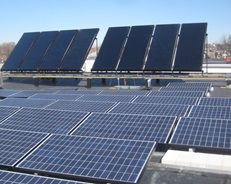Sustainable Development & Greening of Affordable Housing

Affordable housing in Cambridge has been leading the way with sustainable building practices and green design. Dating back to projects such as CAST I, Scouting Way, and Trolley Square and continuing to more recent projects such as Main and Cherry Condominiums, Pine Street, the Print Shop Condominiums and Elm Place and Putnam Green, affordable housing in Cambridge is designed, constructed, and maintained using sustainable development principles and green materials. Housing built with City funding assistance will be affordable for the long-term, and so it is built to last. The use of high-quality, durable materials has been a standard feature of Cambridge affordable housing developments for many years.
Healthy and sustainable development results in lowered operating costs and reduced maintenance costs, and most importantly, better homes for residents, and a healthier environment for everyone. The benefits of reducing use of natural resources will grow over time and are consistent with the City's climate protection and environmental goals. By maximizing energy efficiency and conservation in design, using healthier materials and finishes, and, in many cases, including renewal energy components, the City’s affordable housing developments have become models for sustainable development.
Green features often include:
- Renewable energy: solar hot water and solar electric systems
- Energy efficient appliances and lighting
- Low flow plumbing fixtures
- High efficiency boilers with programmable thermostats
- Air Sealing: caulking all exterior walls at junctions, all unit separation walls, all electrical and HVAC punctures in drywall
- Super insulation: damp blown cellulose insulation in exterior and unit separation walls, minimum of 5.5” at exterior
- Double-pane insulated glass windows with low-E coatings and argon filled glazing
- Energy recovery system (ERV) to provide fresh air while extracting heat or cooling from exhaust air to pre-condition incoming air for heating or cooling
- Construction waste management and recycling plan
- Use of materials with recycled content in project. Such as PVC free flooring, fly ash in concrete, and siding made from recycled materials